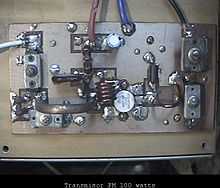RF power amplifier
.jpg)

An RF power amplifier is a type of electronic amplifier used to convert a low-power radio-frequency signal into a larger signal of significant power, typically for driving the antenna of a transmitter. It is usually optimized to have high efficiency, high output Power(P1dB) compression, good return loss on the input and output, good gain, and optimum heat dissipation.
RF amplifiers formerly were all made used vacuum tubes (called valves in some English-speaking countries. Tubes are still used for exceptionally high-power transmissions (see Valve RF amplifier).
Applications
The basic applications of the RF power amplifier include driving to another high power source, driving a transmitting antenna and exciting microwave cavity resonators. Among these applications, driving transmitter antennas is most well known. The transmitter–receivers are used not only for voice and data communication but also for weather sensing (in the form of a radar).
Wideband amplifier design
Impedance transformations over large bandwidth are difficult to realize, thus most wideband amplifiers use 50 Ω output loading. Transistor output power is then limited to
 is defined as the breakdown voltage
is defined as the breakdown voltage
 is defined as the knee voltage
is defined as the knee voltage
and typically 
The loadline method is often used in RF power amplifier design.[1]
References
- ↑ Matthew Ozalas (January 14, 2015). "How to Design an RF Power Amplifier: The Basics". youtube.com. Retrieved 2015-02-10.
External links
| Wikimedia Commons has media related to RF power amplifiers. |
- Carlos Fuentes (October 2008). "Microwave Power Amplifier Fundamentals". Retrieved 2013-03-05.
- Khanifar, Ahmad. "RF Power Amplifier Design for Digital Predistortion". http://www.linamptech.com/''. Retrieved 1 December 2014.
